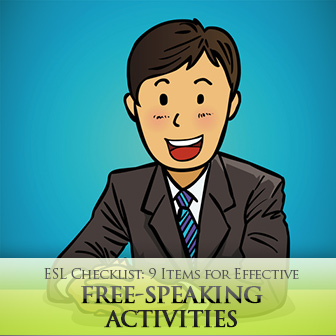Speaking is an essential skill in learning English as a second language – most students agree that this is what they struggle with the most. Still, many of us focus most of our efforts on drilling and repetition of phrases and dialogues.
While it’s a great start for beginners, at some point students need to have speaking activities that will allow them to improve their communication skills, which takes a lot more than a repetition of phrases. Free-speaking activities are perfect for this. Here are the main points to consider when using free-speaking activities in your ESL class.

What free speaking is and what it’s not
A good free-speaking activity is not synonymous to free conversation time. This is not the time to speak about whatever they want, with no given goal or objective. Free speaking means that students have the chance to use the language resources they deem to be necessary and/or useful to achieve the task.
There are 3 essential Ps in language teaching: presentation (introduction of topic/new vocabulary/language item), practice (drilling and repetition) and performance. Free speaking corresponds to performance. It’s the chance they have to put everything they’ve learned to good use.

ESL Checklist for Effective Free-speaking Activities:
-
1
Does it have a clear learning goal?
Why are you using this free-speaking task? Are you giving your class a chance to practice vocabulary they’ve just learned? Review grammar, phrases or expressions? Free-speaking activities can’t just be a time to speak freely, there has to be some connection to something students have been presented and practiced recently. Say you recently taught them expressions for agreeing/disagreeing. Give them a chance to use them!
-
2
Is there a clear objective?
Students won’t know if they have successfully achieved the learning goal if they don’t know what the task objective is. Do they have to reach an agreement? Find a solution to a problem? Brainstorm ideas? Here are some examples of speaking tasks with clear objectives:
- Students must reach an agreement on where to have a friend’s surprise party.
- One student tells the class about his/her eating habits and lifestyle. The rest of the class has to provide ideas for a healthier lifestyle.
- Students discuss ways to protect the environment and come up with a list of 10 ideas they can start implementing today.
-
3
Is it fun/interesting/appropriate?
It goes without saying that the success of the activity hinges on how engaged your students are. And activities that are not fun or interesting will fail to engage them. Try tailoring each activity to your student’s interests and level. For a group of Business English learners, change the surprise birthday party scenario mentioned above; have the class reach an agreement on where to host a conference/meeting,
-
4
Is it competitive?
Young students and teens, in particular, thrive in healthy competition. Is there a way of breaking the class into teams, so they can compete to provide the best/most ideas/results? See which group comes up with the most ideas to protect the environment.
-
5
Is it challenging?
Speaking tasks that are too easy will be over in 5 minutes. Good speaking tasks last at least 10-15 minutes – remember you want to give your students a chance to speak. Have you introduced and obstacle or complication they must overcome? Here are some complications for the surprise birthday party scenario:
- Give them a limited budget
- Tell them that because it’s winter, they can’t have the party outdoors
- They only have three days left to plan and buy everything!
-
6
Will there be something to report in the end?
Good free-speaking tasks give students something they can summarize/report to the rest of the class. Will they be able to provide an action plan for the surprise birthday party? A list of tasks and who's responsible for each?
-
7
Is it structured?
What is the procedure your students should follow? Is it clear? A structured activity gives students who are not so confident a backbone to support them. For the birthday party scenario, give students the items they must decide on:
- Venue
- Food
- Music
- Date and time
- Number of Guests
- Etc…
-
8
Can it be repeated?
When they are done, and you give them your feedback, can they re-enact it? Reenactments gives them a chance to fine tune things that were not so accurate so that they can improve their previous performance. Did they forget to decide on a date and time? No one’s taking care of the music? Re-enact the discussion and try not to forget these points.
-
9
Is there enough room for students to show their creativity?
Even structured free-speaking tasks need to give students enough wiggle room to make adjustments as they go, and find creative solutions to problems. If there’s no money for the DJ, one of your students may volunteer to be the DJ for the night.
What you need to do is create an environment where students speak freely - not a free- for-all. Give them the right indications, and they will do just that.
What's your experience with free-speaking activities? If you have tips to share, speak freely and share them below!
P.S. If you enjoyed this article, please help spread it by clicking one of those sharing buttons below. And if you are interested in more, you should follow our Facebook page where we share more about creative, non-boring ways to teach English.







